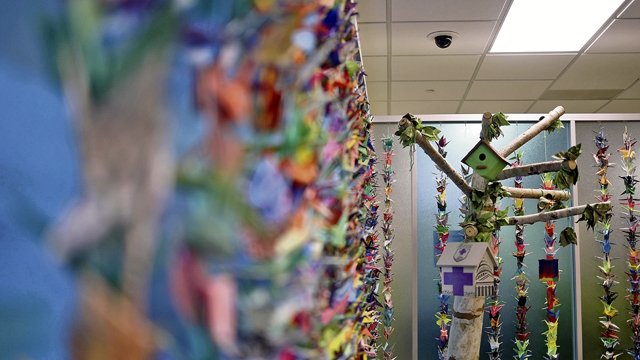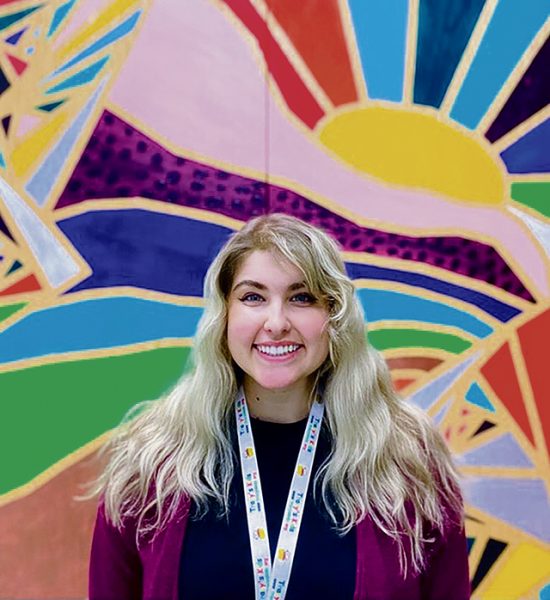
A voyage of discovery
Like most aspiring artists, Sara C. Cantrell envisioned creating paintings, drawings, and sculptures that provoked curiosity and conversations. Seeking to make a career of her artistic talent — and leaning towards a career as an academic, she earned a bachelor’s in fine art from The South Carolina School of Arts at Anderson University and a master’s in art therapy from George Washington University.
During her second year of graduate school, she fortuitously landed an internship with the Walter Reed National Military Medical Center’s Pediatric Hematology Oncology Clinic. Cantrell loved the work, the patients, and the mission.
“I’ve always had a natural inclination for working with children, not directing them but encouraging them to be creative and explore their own identities,” shared Cantrell.
Now a staff pediatric art therapist with the PHOC, Cantrell starts her day in a morning huddle with doctors, social workers, and other clinical staff members.
“Each day is different in our clinic, and I aim to know what treatment and/or procedures patients are receiving so that I may determine how to orient my schedule,” said Cantrell, determined to create a tailored approach to provide artistic interventions for each patient.

Cultivating community
When working indoors, Cantrell conducts art therapy at the art table, on an easel, or in patients’ rooms. Her goal is to embrace the flow of the clinic while ensuring patients have a creative outlet leading to better health.
“Sometimes patients want to work as a group or side by side at the art table; other times I’m working with a sibling or family group,” explained Cantrell, who admires the sense of community that pediatric patients share.
Cantrell cultivates community by promoting interaction among patients, family, and staff — even encouraging participation from nurses and doctors, testing their artistic acuity, and inviting critiques from this community of artists.
“Contrary to a common misconception that art therapy is solely about coloring and having fun, its primary goal in the Pediatric Hematology-Oncology clinic is to offer patients a space for self-expression and exploration, tailored to their needs,” emphasized Cantrell, protective of the meaningful role that art therapy plays in healing patients.
“In a challenging time when control might seem elusive, art therapy provides patients with a choice — a chance to say no to something when they might not have that option elsewhere, like declining medical procedures, hospital admission, or even taking medication,” explained Cantrell.
Along her journey, Cantrell credits her mentors with sharing their perspectives and experiences, enabling her to become an even more passionate advocate for her patients.
Rewarding moments for Cantrell stem from observing patients empower themselves through their choices, navigating their experiences, and reclaiming control, confided Cantrell.
“Whether it’s a two-year-old patient establishing a routine through art to prepare for a tough experience or an adolescent patient constructing an art museum with each wall representing phases of her treatment and her fears around it, the impact of art therapy is evident,” shared Cantrell.
Over time, that child patient became an adolescent seeking a new adventure to express her creativity and resolve. So, Cantrell and the patient created dragon puppets, each with powerful deformities: unique characters with superpowers beyond casual observation.
“The time spent on art means more to patients than most would ever guess, serving as a coping mechanism in an otherwise intimidating hospital environment,” explained Cantrell, painting a picture for those seeking to understand a child’s perspective.
Cantrell’s role in creating a welcoming space and providing an outlet through art therapy eases the fear commonly associated with entering a hospital, and it’s a deeply gratifying and rewarding part of her position at Walter Reed.
“The countless experiences and connections I have been privileged to have with patients and their families are invaluable,” said Cantrell, emotionally connecting to the transformation her patients undergo, profoundly affecting her life.
Maintaining physical and emotional resilience
Cantrell said she’s cultivated a strong support network personally and professionally, a de facto health care team helping her maintain a work-life balance that keeps her physically, mentally, and emotionally strong.
“I have amazing colleagues who provide a true sense of camaraderie, and I participate in regular supervision to navigate the emotional complexities inherent in this line of work,” shared Cantrell. “Establishing healthy boundaries is key; allowing for a disconnection from work helps me to ground myself and balance my life.”
Cantrell takes ownership of her emotional health by connecting with her therapist and intentionally pursuing joyful habits: taking nature walks or doing yoga.
Spreading joy by expanding the reach of art therapy
Cantrell’s Christmas wish was to expand art therapy activities to all pediatric clinics at Walter Reed, creating an amazing pathway for more military families and their children to benefit from the therapeutic rewards of art therapy while cultivating community here at Walter Reed and beyond.


